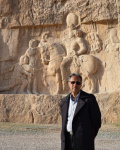| نویسندگان | Zeynab Barati, Mohsen Javeri |
|---|---|
| نشریه | Journal of Handicrafts Iran |
| شماره صفحات | ۵۷ |
| شماره مجلد | ۳ |
| نوع مقاله | Full Paper |
| تاریخ انتشار | 1399/02/01 |
| رتبه نشریه | علمی - پژوهشی |
| نوع نشریه | چاپی |
| کشور محل چاپ | ایران |
چکیده مقاله
One of the most important factors to affect artworks throughout history is religion. The territorial integrity of Islamic lands is one of the factors that influenced Islamic pottery. Islam has had a considerable impact on all aspects of Muslims’ lives, including art and specifically pottery. During the 3rd and 4th centuries AH (9th and 10th centuries AD), coinciding with the Abbasid dynasty, similar practices were observed in Islamic pottery. With the discovery of pottery in regions like Nishapur and Samarra, different theories have been raised. This article aims to study the characteristics and techniques of the pottery of each of these areas by studying them in the mentioned time period. The research explains as well the variable techniques, differences and similarities between the pottery produced in Nishapur and Samarra during the 3rd and 4th centuries in addition to the impacts other cultures have had on them in terms of techniques.
This study adopts an analytical-descriptive approach by using library resources to achieve the intended objectives. The research seeks answering some questions relating to features such as the qualification of Nishapur and Iraq pottery variation in techniques of manufacture and glazing, as well as the similarities and differences among such products, and the investigation of the influence of external techniques and styles on Persian tradition of pottery. The results of the study confirm the fact that the variation of shapes in Nishapur pottery mostly consists of bowls, punch bowls and plates with flat and occasionally flattened elongated bodies and ring bases. The pottery herein is decorated with mud coating techniques, white enamel painting, as well as those of underglaze white and ultramarine, splashed, engraved and luster. Samara pottery at the same time is often produced in the form of plates, bowls, vertical walled cups, and no-pot pitchers with vertical handles, using mud coating techniques, white-brown and ultramarine paint, matt white glaze imitating porcelain, and the glaze sprinkled with luster. Differences in body composition of the Samarra and Nishapur pottery are evident, and the base ring is one of the features that could not be copied, displaying its own characteristic in each region. Examples of similar pottery in Nishapur and Samarra show the influence of Sassanian art, Chinese art, and pottery in Iraq, being the unique features of the Abbasid pottery. Politics, commerce, family relations, and the gathering of craftsmen and artists in Baghdad as well as the possibility of trading on the sea have also had a considerable effect in creating such works.
